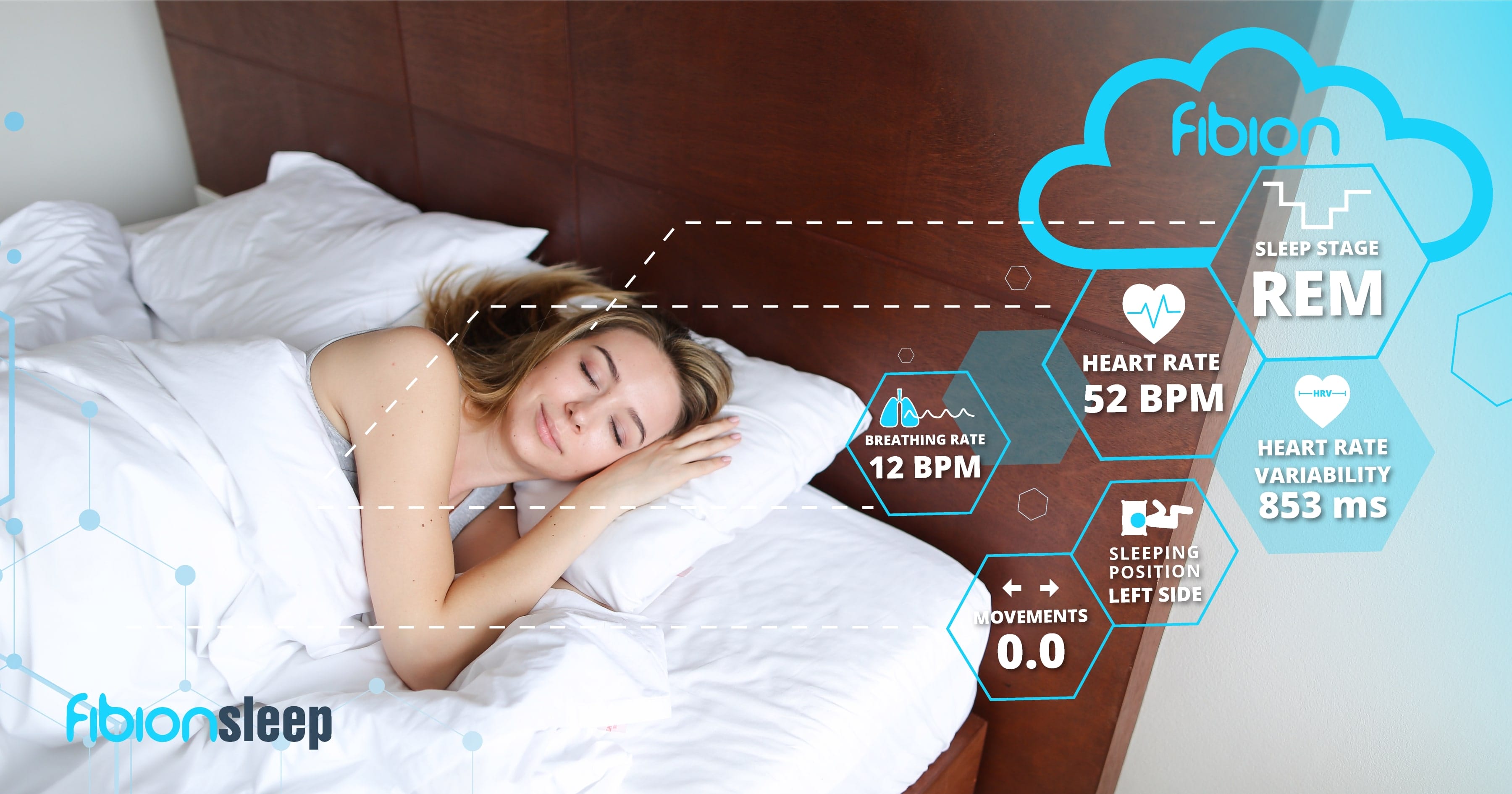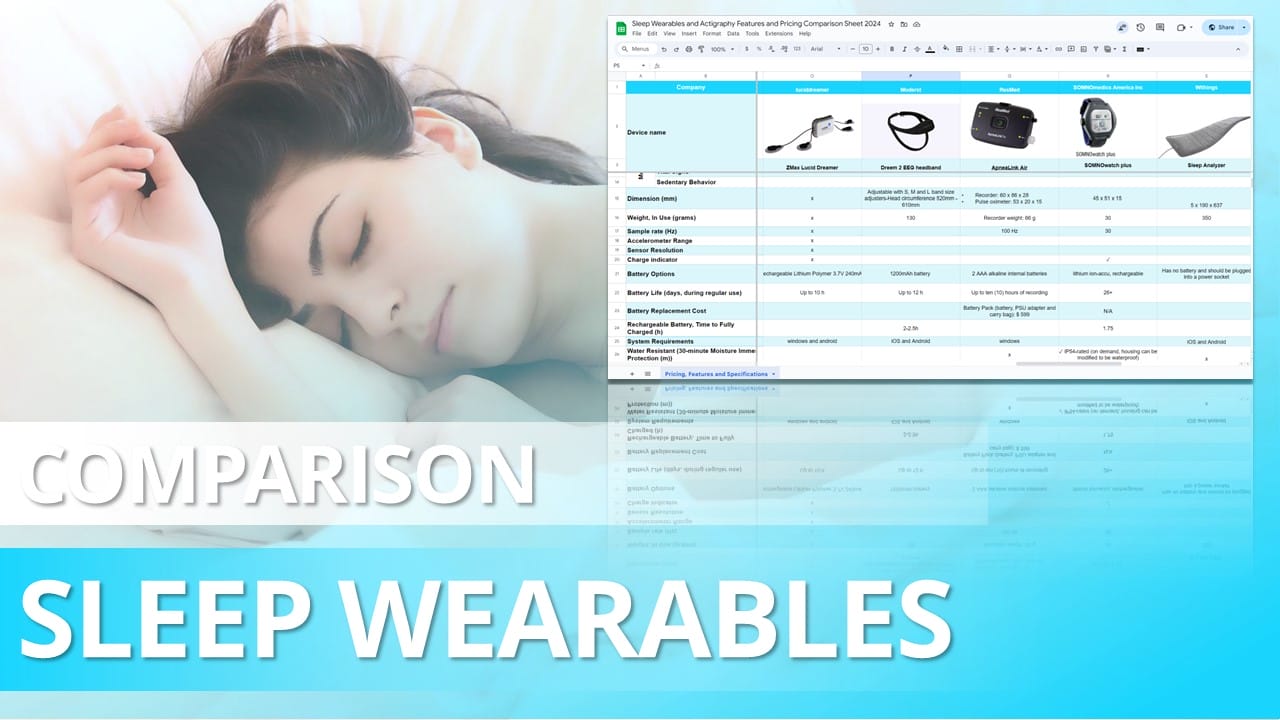How to Access the Comparison Sheet
1. Provide Email: Click here.
2. Receive Link: In a few seconds, you receive an email containing the link to the comparison sheet.
3. Make Informed Choices: Use the sheet to compare and select the sleep wearable or actigraphy device that meets your research needs.

1. Introduction
In the world of scientific research, selecting the appropriate sleep wearable or actigraphy device is crucial for monitoring sleep patterns and activities accurately. These devices are essential tools in studies focusing on sleep disorders, daily activity monitoring, and overall health and wellness. This guide aims to equip researchers with essential information to make informed choices when evaluating sleep wearables and actigraphy devices for their unique project needs.
The decision to choose one device over another should be guided by several key factors:
- Specifications and Features: Different studies require devices with specific functionalities. Understanding and comparing these features is vital.
- Pricing: Budget constraints often dictate the choice of equipment. A comparative analysis of pricing helps in planning and allocating resources efficiently.
- Research Goals Alignment: The selected device must align with the project’s objectives, ensuring accurate data collection relevant to the study’s goals.
“Choosing the right sleep wearable or actigraphy device isn’t just about specs; it’s about ensuring accuracy and reliability for comprehensive sleep research.”
This guide, centered on a comprehensive comparison sheet, is crafted to assist researchers in navigating these considerations effectively. With a focus on providing value in each section, we’ll delve into how to utilize the comparison sheet to its full potential, ensuring a straightforward approach to selecting the most suitable device for your research endeavors.

2. Exploring the Sleep Wearables and Actigraphy Comparison Guide
The comparison sheet is a meticulously organized document designed to streamline the decision-making process for researchers. Here’s how to navigate it effectively:
2.1. Key Columns and What They Represent
- Model Name: The specific name or number given to the device by the manufacturer.
- Manufacturer: The company that produces the device.
- Price: The cost of the device, providing a basis for budget considerations.
“For seamless research, pick sleep wearable that simplify data management and integrate effortlessly, backed by solid technical support.”
Specifications:
- Measurement Sensitivity: How responsive the device is to movement or sleep stages.
- Battery Life: How long the device can operate before needing a recharge or battery replacement.
- Data Output Format: The format in which the device delivers the collected data, e.g., CSV, JSON.
Features:
- Wireless Connectivity: Whether the device can transmit data wirelessly or requires a physical connection.
- Water Resistance: Indicates if the device can be used in wet conditions or submerged.
- Compatibility: The software or platforms with which the device is compatible.
2.2. How to Use the Sheet for Comparison
- Define Your Criteria: Start by listing the specific requirements of your research project. Consider what specifications and features are non-negotiable and which ones are flexible.
- Filter and Sort: Use the comparison sheet’s filtering and sorting functions to narrow down the list of devices that meet your predefined criteria.
- Highlight Differences: Pay special attention to the differences in specifications and features among the shortlisted devices. Note the advantages and limitations of each model concerning your research needs.
- Evaluate Pricing: Once you have a list of potential devices, compare their prices. Consider the value each model offers in terms of its features and specifications relative to its cost.
- Consult Reviews: If available, consult user reviews or scientific evaluations of the devices. Real-world insights can provide valuable information beyond what is captured in the comparison sheet.
“Getting the comprehensive sleep wearable comparison sheet is easy: Request, receive by email, or access online. It’s your key to informed device selection.”
2.3. Tips for Effective Comparison
- Be Methodical: Take a systematic approach to comparison. Avoid jumping between models without a clear comparison strategy.
- Consider Future Needs: While current project requirements are paramount, considering future research needs can provide more flexibility and long-term value.
- Seek Advice: Don’t hesitate to seek advice from colleagues or the scientific community. Often, personal experiences with specific models can offer insights not evident in specification sheets.
By following these guidelines, researchers can harness the full potential of the sleep wearables and actigraphy comparison sheet, ensuring they select the most appropriate device for their specific research projects in a logical, informed manner.

3. Using the Comparison to Select the Right Sleep Wearable or Actigraphy Device
Selecting the right sleep wearable or actigraphy device is a critical step in ensuring the success and accuracy of your research project. The comparison sheet serves as a powerful tool in this process, providing detailed insights into various models. Here’s how to leverage this information to make an informed choice:
3.1 Specifications and Features Comparison
- Identify Must-Have Specifications: Start by highlighting the specifications crucial for your research. For example, if studying detailed sleep stages, prioritize devices with high measurement sensitivity.
- Assess Additional Features: Look beyond basic specifications to features that could enhance your research. Wireless connectivity, for instance, could significantly streamline data collection in field studies.
“The comparison sheet turns complexity into clarity: Save time, plan your budget, and make informed choices to match accelerometers with your research vision.”
3.2 Pricing Comparison of Devices
- Align with Your Budget: Use the pricing information to identify devices that fit within your allocated budget. Consider not only the initial cost but also potential expenses for accessories or extended warranties.
- Cost-Benefit Analysis: For each model within your budget, perform a cost-benefit analysis. Weigh the price against the benefits derived from each device’s specifications and features.
3.3 Identifying the Ideal Device for Your Project
- Match Device Capabilities to Project Goals: Ensure the devices you consider align with your project’s objectives. A device that measures with high precision but lacks the necessary range for your research might not be the best choice.
- Consider Long-Term Usability: Evaluate whether a potential device can be utilized in future projects. Investing in a more versatile device might offer better long-term value.
- Trial and Testing: Whenever possible, test a shortlist of devices in a controlled environment to assess their performance first-hand. This step can provide clarity and confidence in your final decision.
3.4. Key Decision-Making Factors
- Accuracy and Precision: Essential for the validity of your research findings. Ensure the device’s accuracy and precision meet your study’s requirements.
- Ease of Integration: Consider how easily the device can be integrated into your existing research setup, including software compatibility and data management systems.
- User Feedback: Seek out feedback from other researchers who have used the devices on your shortlist. Their experiences can provide valuable insights into each device’s real-world functionality and reliability.
- Support and Warranty: Investigate the manufacturer’s support options and warranty coverage. Good customer support and a robust warranty can mitigate potential issues down the line.
“Pick the perfect sleep wearable—make your research precise, easy, and groundbreaking.”
By meticulously analyzing the comparison sheet and considering these strategic factors, researchers can select the right sleep wearable or actigraphy device that not only meets their current project’s specific needs but also aligns with future research endeavors. This approach ensures an investment in a tool that contributes to the integrity and success of scientific research.

4. Key Considerations in Sleep Wearables and Actigraphy Selection
Selecting the right sleep wearable or actigraphy device involves more than just evaluating technical specifications and pricing. It’s crucial to consider the practical aspects of how the device will be used by participants and researchers. These considerations ensure the success of data collection efforts and the overall feasibility of the research project.
User Experience and Participant Compliance:
- Simplicity of Use: Devices should be easy for participants to use without complex setup processes.
- Comfort and Wearability: Ensure the device is comfortable, especially for continuous wear.
- Waterproofing: Devices should withstand water if required by the study environment.
- Visibility and Discretion: Less visible devices tend to be more acceptable to participants.
- Charging Requirements: Long battery life is essential to minimize charging frequency, enhancing participant compliance.
Ease of Use for Researchers:
- Data Access and Management: Look for devices that allow easy data access and management.
- Remote Control Features: Devices with remote control capabilities enhance flexibility in data collection.
- Software Integration: Ensure the device is compatible with existing data analysis software.
- Technical Support: Prioritize devices from manufacturers with reliable technical support.
5. Accessing the Comprehensive Sleep Wearables and Actigraphy Comparison Sheet
Request Access: Access is typically granted through a simple request form where researchers provide their email address to receive a direct link to the comparison sheet.
Email Distribution: The comparison sheet is sent via email. Ensure to check your inbox and spam folder for the link.
Online Portal Access: Some comparison sheets are hosted on an online portal, providing up-to-date information with secure access.
Follow-Up Support: After accessing the comparison sheet, you might have questions or need further clarification, for which contact information is typically provided.
Benefits of Using the Comparison Sheet:
- Time-Saving: Quickly compare multiple devices, saving valuable research planning time.
- Budget Planning: Efficiently allocate your research budget with clear pricing information.
- Informed Decisions: Make choices based on comprehensive data, matching devices with your research needs.
6. Conclusion: Empowering Research with the Right Sleep Wearable or Actigraphy Device
Selecting the ideal sleep wearable or actigraphy device is a crucial step in conducting research that is both impactful and precise. The comprehensive comparison sheet isn’t just a resource; it’s a key to making informed choices, enabling researchers to find devices that perfectly match their project goals. By thoroughly examining each device’s features, specifications, and cost, researchers can ensure their choice meets the rigorous demands of scientific investigation, improves the quality of data collected, and ultimately, furthers the progress of knowledge in their area of study.
The journey to choosing a sleep wearable or actigraphy device demands deliberate thought and careful weighing of the device’s technical attributes against its practical application in research contexts. The correct choice can notably improve the quality of your research, unlocking new insights and discoveries that were once out of reach. As methodologies in sleep and activity research evolve, staying updated on the latest developments in wearable and actigraphy technology is crucial to maintaining the cutting edge in scientific inquiry.
Further Reading and Resources on Sleep Wearables and Actigraphy
To deepen your understanding of sleep wearables and actigraphy and stay updated on the latest trends, technologies, and applications in sleep research, consider exploring the following resources:
- Heart Rate Variability (HRV) in Sleep Research: A comprehensive guide to the use of HRV metrics in sleep studies, offering insights into cardiovascular health during sleep. Read more.
- Analyzing Sleep Patterns through Actigraphy: Dive into the methodologies and best practices for utilizing actigraphy to analyze sleep patterns and rhythms. Learn more.
- Key Methods in Respiration Measurement During Sleep: Discover various techniques used to measure respiration, essential for studies on sleep quality and disorders. Explore further.
- Wearable Monitors in Sleep Apnea Research: Unveil the role of wearable technology in advancing research on sleep apnea, including device accuracy and application. Find out more.
- Comparison of Home Sleep Apnea Research Tools: Address common obstacles and compare different tools used in home-based sleep apnea research. Investigate further.
- Fibion Vitals in Sleep-Disordered Breathing (SDB) Monitoring: Look into how Fibion Vitals is revolutionizing the monitoring of sleep-disordered breathing with cutting-edge technology. Read more.
- Comparing Fibion Vitals and Withings in Home Sleep Apnea Research: Analyze the differences and advantages of Fibion Vitals and Withings devices in the context of home sleep studies. Learn more.
- The Role of Multifunctional Sleep Devices: Explore how multifunctional devices are integrated into sleep studies, enhancing data collection and analysis. Explore further.
- Fibion Vitals vs. Polysomnography (PSG) in Sleep Research: Compare the effectiveness and convenience of Fibion Vitals against traditional PSG techniques in sleep research. Find out more.
These articles and resources provide a solid foundation for researchers looking to expand their knowledge and proficiency in using sleep wearables and actigraphy. By leveraging these insights, you can enhance the design, execution, and outcomes of your research projects.
You Might Also Be Interested
⭐ Best tools to measure sleep at home 2024. Read the article here.
📅 Planning research measuring sleep? Book a session with Dr. Olli Tikkanen.
Frequently asked questions:
What are the key factors to consider when choosing a sleep wearable for research? +
When selecting a sleep wearable or actigraphy device, consider specifications like measurement sensitivity and battery life, pricing, and how well the device aligns with your research goals.
How can the comparison sheet aid in selecting the right sleep wearable? +
The comparison sheet helps streamline the selection process by providing detailed information on each device’s specifications, features, and pricing, allowing for easy comparison and informed decision-making.
What should be prioritized if the research involves detailed sleep stage analysis? +
For detailed sleep stage analysis, prioritize devices with high measurement sensitivity and specific features that enhance the accuracy of sleep stage detection.
How does wireless connectivity enhance sleep research? +
Wireless connectivity in sleep wearables facilitates easier and more flexible data collection, especially in field studies or when continuous monitoring is required without disturbing the participant.
What are the benefits of considering future research needs when choosing a device? +
Considering future research needs can provide more flexibility and long-term value, ensuring that the device remains applicable and useful for upcoming projects and evolving research requirements.
Why is user feedback important in selecting sleep wearables? +
User feedback provides real-world insights into a device’s functionality and reliability, offering perspectives that might not be evident through specification sheets alone.













